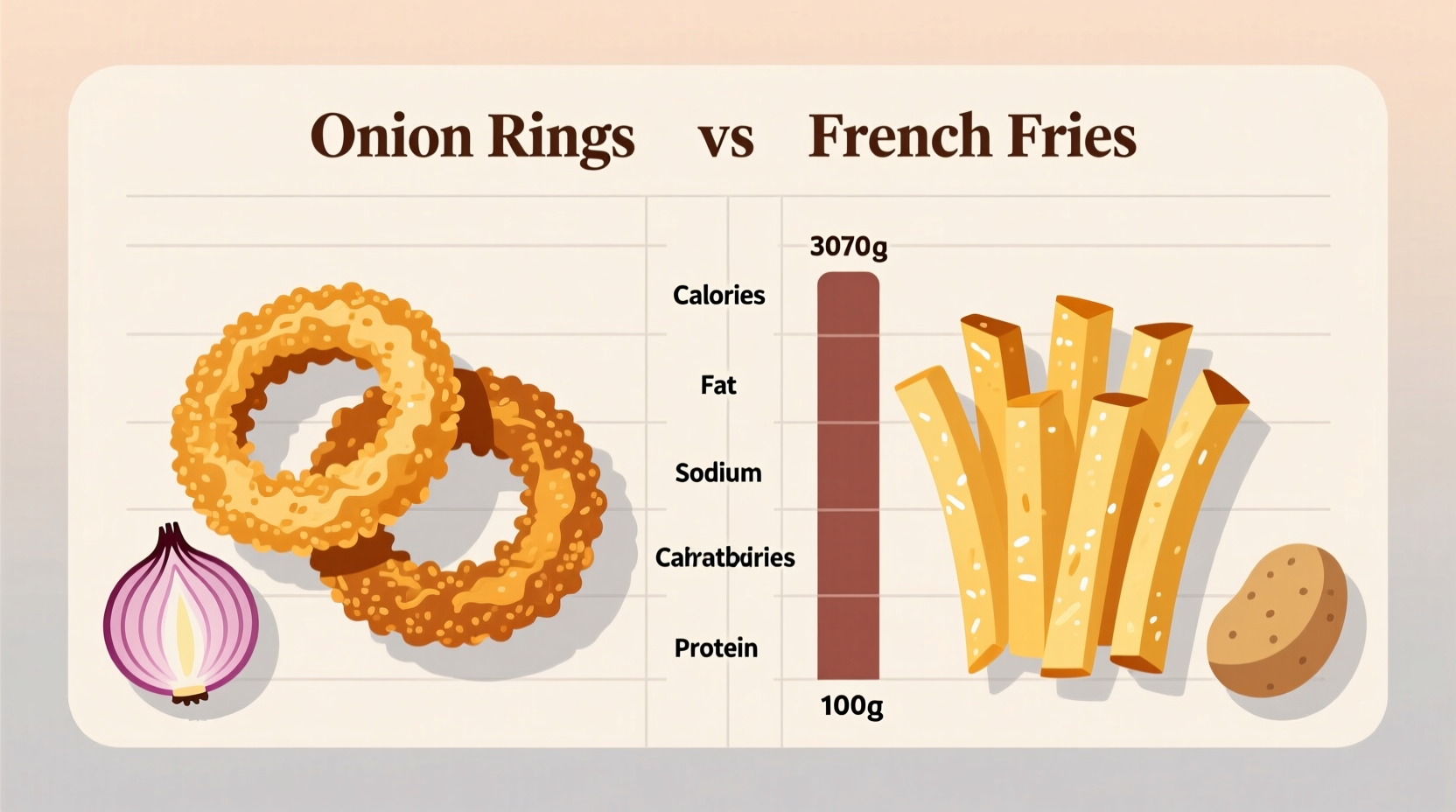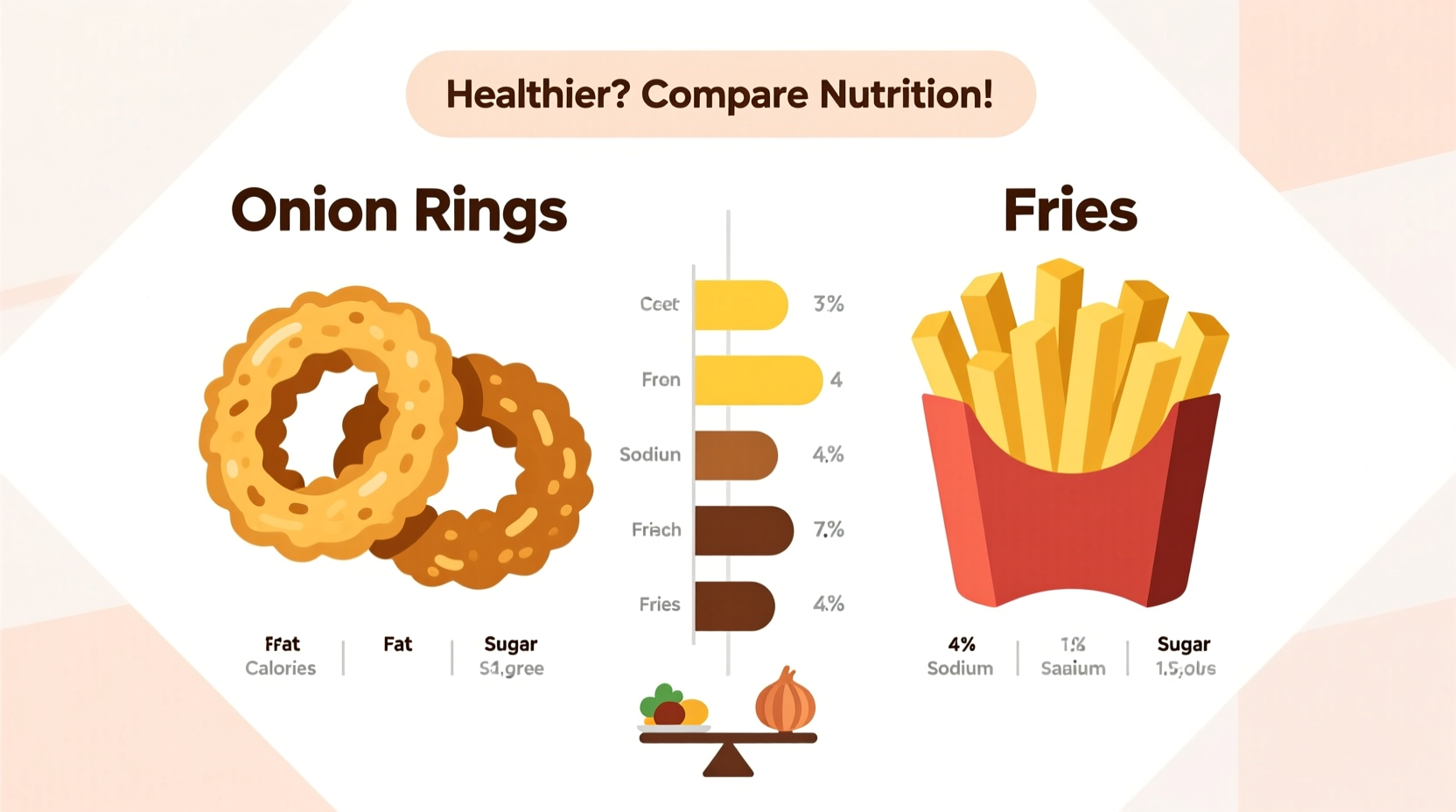When you're deciding between onion rings and French fries at your favorite restaurant, you're probably wondering which option is the better choice for your health goals. This common menu dilemma deserves a clear, evidence-based answer—not marketing hype or oversimplified claims. Let's break down exactly how these two popular side dishes compare nutritionally, when one might be a slightly better option, and how to make smarter choices regardless of which you select.
Nutritional Face-Off: Onion Rings vs French Fries
Understanding the nutritional differences requires looking beyond surface-level assumptions. Many people assume onion rings must be healthier because they contain actual vegetables, but the preparation method dramatically changes their nutritional profile.
| Nutrient (per 100g) | French Fries | Onion Rings |
|---|---|---|
| Calories | 312 kcal | 350 kcal |
| Total Fat | 14.7g | 17.2g |
| Saturated Fat | 3.2g | 3.8g |
| Carbohydrates | 41g | 45g |
| Fiber | 3.8g | 2.5g |
| Sodium | 246mg | 450mg |
Data sourced from the USDA FoodData Central shows that while both options are nutritionally similar, onion rings generally edge out French fries in negative categories. The extra batter used for onion rings, combined with the natural sugars in onions that caramelize during frying, creates a product with slightly higher calories, fat, and carbohydrates.
Why Onion Rings Aren't the Vegetable Boost You Might Expect
Despite containing actual onions—which do offer beneficial compounds like quercetin and sulfur compounds—the deep-frying process significantly alters their nutritional value. The high heat degrades many heat-sensitive nutrients, and the batter adds substantial refined carbohydrates and additional fat absorption.
According to research published in the Journal of Food Science, deep-frying vegetables can increase their fat content by 40-60% depending on the oil temperature and duration. The batter used for onion rings creates a barrier that actually increases oil absorption compared to the simpler surface of French fries.

Cooking Method Matters More Than You Think
The preparation technique significantly impacts the final nutritional profile of both foods. Restaurant-prepared versions typically use older oil that has broken down, creating more harmful compounds. The temperature at which foods are fried affects oil absorption—lower temperatures cause more oil to be absorbed.
When comparing homemade versions prepared with an air fryer using minimal oil, both options become substantially healthier. Air-fried French fries contain approximately 40% less fat than traditionally deep-fried versions, while air-fried onion rings show a 35% reduction.
When One Option Might Be Slightly Better
While neither option qualifies as "healthy," there are specific contexts where one might be a marginally better choice:
- For blood sugar management: French fries generally have a slightly lower glycemic index (75) compared to onion rings (82), meaning they cause a slower rise in blood sugar.
- For fiber intake: French fries typically contain more fiber due to the potato skin remaining intact in many preparations.
- For sodium concerns: French fries usually contain less sodium unless heavily salted after cooking.
However, these differences are relatively small in the context of an overall balanced diet. The larger issue is the frequency of consumption and portion size.
Practical Strategies for Healthier Choices
Instead of focusing solely on which fried option is "less bad," consider these evidence-based approaches:
- Portion control: Order a side instead of a full portion—most restaurant servings contain 2-3 times the standard serving size.
- Ask about preparation: Some establishments use fresher oil or double-fry methods that reduce oil absorption.
- Request no extra salt: This can reduce sodium content by up to 30%.
- Pair with nutrient-dense foods: Balance your meal with a substantial salad or vegetable side.
- Consider frequency: Occasional indulgence has minimal impact, but regular consumption of fried foods correlates with increased health risks.
Research from the American Heart Association indicates that consuming fried foods more than once a week is associated with a higher risk of heart disease. The key isn't choosing between two unhealthy options but developing strategies to enjoy them occasionally without compromising your health goals.
Making Smarter Homemade Versions
If you're preparing these at home, you can significantly improve their nutritional profile:
- Use an air fryer instead of deep frying
- Choose heart-healthy oils like avocado oil with higher smoke points
- For onion rings, use a light whole-wheat batter instead of traditional white flour
- Leave potato skins on for French fries to increase fiber content
- Season with herbs and spices instead of salt
These modifications can reduce fat content by 30-50% while maintaining satisfying texture and flavor. The cooking technique matters more than the specific food choice when it comes to nutritional impact.
Final Verdict: It's About Context, Not Just Comparison
Labeling either onion rings or French fries as "healthy" would be misleading. Both are occasional indulgences rather than regular dietary components. The nutritional differences between them are relatively minor compared to the larger question of how frequently you consume fried foods and what they're replacing in your diet.
As Antonio Rodriguez, culinary expert with expertise in food chemistry, explains: "The preparation method transforms what might otherwise be nutritious ingredients into high-calorie, high-fat foods. Whether it's potatoes or onions, the deep-frying process creates similar nutritional outcomes regardless of the starting ingredient. Your focus should be on preparation technique and frequency rather than choosing between two fried options."











 浙公网安备
33010002000092号
浙公网安备
33010002000092号 浙B2-20120091-4
浙B2-20120091-4